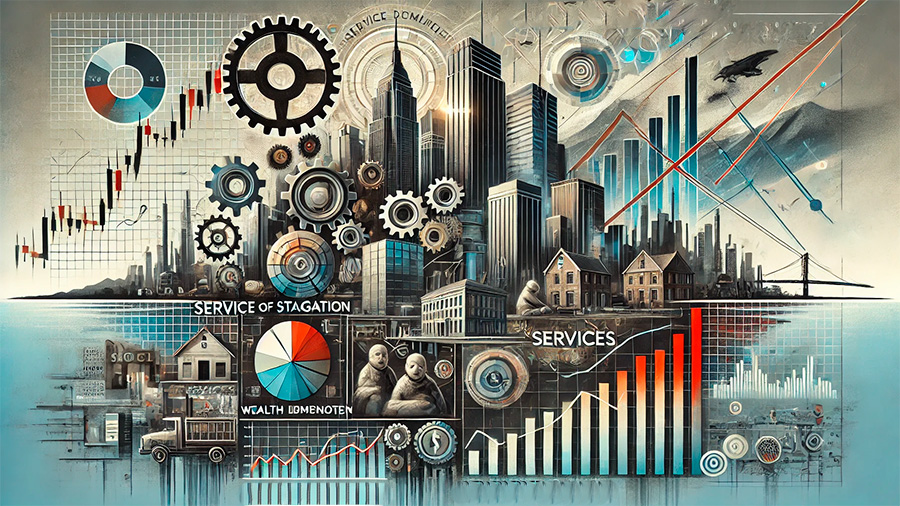As economies evolve, the balance between different sectors—manufacturing, agriculture, services, and technology—plays a critical role in sustaining long-term growth and stability. In recent decades, many developed nations have seen a shift toward service-based economies, where industries such as finance, healthcare, education, and hospitality dominate. While this shift has brought numerous benefits, over-reliance on services can lead to significant economic risks. A service-heavy economy, without the necessary balance of production and innovation in other sectors, can experience stagnation, reduced growth, and a decline in economic resilience. This article explores the potential dangers of an economy that relies too heavily on services, highlighting the risks of imbalance and how such an economy might face long-term challenges.
What Constitutes a Service-Heavy Economy?
A service-heavy economy refers to a nation or region where the majority of economic output comes from the services sector, rather than manufacturing, agriculture, or raw material extraction. In many cases, services like finance, real estate, healthcare, and education contribute disproportionately to GDP, employment, and national income. While services are undoubtedly important in driving economic growth, they should ideally be complemented by a robust industrial and manufacturing base to maintain overall economic stability.
1. The Shift Toward Services
The global shift from manufacturing to services has been driven by factors such as globalization, technological advancements, and the increasing complexity of economies. Services often provide high added value, employ skilled workers, and contribute significantly to economic growth. However, without a foundation of tangible goods production, service-heavy economies risk facing economic instability when external factors disrupt service sectors.
Factors driving the rise of services:
- Technological advancements: Automation and digitalization have made service sectors more efficient, increasing their contribution to GDP.
- Globalization: Outsourcing and trade liberalization have shifted manufacturing jobs to lower-cost regions, while services have remained domestic.
- Consumer demand: Increasing demand for specialized services, such as healthcare, education, and financial services, has driven the growth of the service sector.

The Economic Risks of Over-Dependence on Services
While services are essential to economic growth, an over-dependence on them comes with significant risks. These include reduced productivity, stagnant wages, and economic vulnerability to external shocks. A healthy economy requires a balance between services, manufacturing, and technology sectors to maintain stability, foster innovation, and ensure job creation.
1. Economic Stagnation
In a service-heavy economy, the reliance on intangible goods and services means that the economy may not produce enough tangible products to drive productivity growth. Unlike manufacturing, where innovation often leads to increased production efficiency and the creation of new technologies, services tend to have slower productivity growth. This stagnation can limit overall economic growth and reduce competitiveness on a global scale.
How stagnation occurs in service-heavy economies:
- Slow productivity growth: The service sector generally has slower productivity growth compared to manufacturing, which makes it harder for service-heavy economies to boost output per worker over time.
- Declining innovation: Manufacturing and technology industries tend to foster more innovation, which drives growth in the economy. In contrast, the service sector may not always prioritize groundbreaking innovation, limiting overall progress.
- Reduced economic resilience: Without a strong manufacturing base, a service-heavy economy is more susceptible to global downturns or shifts in consumer behavior, making it more vulnerable to economic shocks.
2. Unbalanced Labor Markets
Service-heavy economies often face an imbalance in their labor markets. High-demand service sectors, such as finance or tech, require specialized skills and higher education levels, leaving lower-skilled workers without sufficient job opportunities. This can lead to rising income inequality, as well as a mismatch between the skills needed in the economy and those available in the workforce.
The impact on labor markets:
- Income inequality: With a growing focus on high-skill service industries, wage disparities between skilled and unskilled workers widen, creating more pronounced income inequality.
- Underemployment: As demand for low-skilled jobs in manufacturing and agriculture decreases, many workers may find themselves underemployed, working in jobs that don’t match their skill sets or fail to offer career advancement.
- Skills mismatch: A shift toward service jobs may create a workforce with skills that are not aligned with the evolving demands of the economy, leaving some workers without viable career paths.
3. Vulnerability to External Shocks
A service-heavy economy is more vulnerable to external shocks, particularly when services are tied to global markets or are subject to sudden changes in demand. For example, the financial crisis of 2008 had a significant impact on service-heavy economies, particularly those reliant on banking and financial services. Similarly, disruptions in global trade or shifts in consumer demand can disproportionately affect service-driven economies, leading to significant economic downturns.
How external shocks impact service-heavy economies:
- Global financial crises: Service-heavy economies with large financial sectors are vulnerable to market instability and financial crises, which can lead to widespread unemployment and lower economic growth.
- Global trade disruptions: Economies dependent on services like tourism, international finance, and education may see their growth and stability compromised by changes in trade agreements or global conflicts.
- Technological obsolescence: Services that rely on specific technologies or platforms may face rapid disruption, making certain sectors vulnerable to technological obsolescence or shifts in consumer preferences.

How to Balance the Economy: Diversification and Innovation
To avoid the risks associated with an over-reliance on services, economies must focus on diversifying their sectors and encouraging innovation across manufacturing, technology, and services. This balanced approach will help maintain economic resilience, boost productivity, and provide sustainable job opportunities for all sectors of the workforce.
1. Encouraging Manufacturing and Technological Development
Manufacturing and technology sectors have historically been the backbone of economic growth, driving productivity improvements and creating innovative products. Governments should incentivize the growth of these sectors through investment in research and development, technological innovation, and infrastructure. A diversified economy that includes strong manufacturing and technology industries is better equipped to weather external shocks and ensure long-term growth.
Strategies to strengthen manufacturing and technology:
- Investment in R&D: Public and private sector investments in research and development can lead to new products, services, and processes that fuel economic growth and innovation.
- Incentivizing innovation: Governments can offer tax incentives, grants, or subsidies for businesses that invest in innovative technologies, such as automation, artificial intelligence, and clean energy solutions.
- Building a skilled workforce: Education and training programs that focus on technical skills can help ensure that the workforce is prepared to meet the demands of a modern, diversified economy.
2. Fostering a Circular Economy
A circular economy, where materials and products are reused, refurbished, and recycled, can help reduce reliance on resource extraction while supporting the growth of both manufacturing and service sectors. By fostering a circular economy, businesses can ensure a sustainable flow of resources, while also creating new industries and job opportunities. This model promotes the idea that services and manufacturing can coexist in a balanced economy.
Key strategies for promoting a circular economy:
- Recycling and waste management: Encouraging industries to adopt sustainable practices such as recycling and waste reduction can create green jobs and reduce the environmental impact of production.
- Designing for reuse: Encouraging the design of products that are easy to repair and recycle can extend the lifespan of goods and reduce the need for new raw materials.
- Collaborative business models: Encouraging businesses to share resources, knowledge, and technologies can create a more integrated economy where both services and manufacturing sectors thrive together.
Conclusion
While the growth of the services sector has brought many benefits, an over-reliance on services alone can lead to significant economic risks, including stagnation, job imbalances, and vulnerability to external shocks. To avoid these dangers, economies must strike a balance by fostering innovation in both manufacturing and services, ensuring that each sector contributes to overall economic growth. By diversifying the economy and encouraging technological development, nations can create more resilient, sustainable, and balanced economies that are better equipped to adapt to the challenges of the future.


